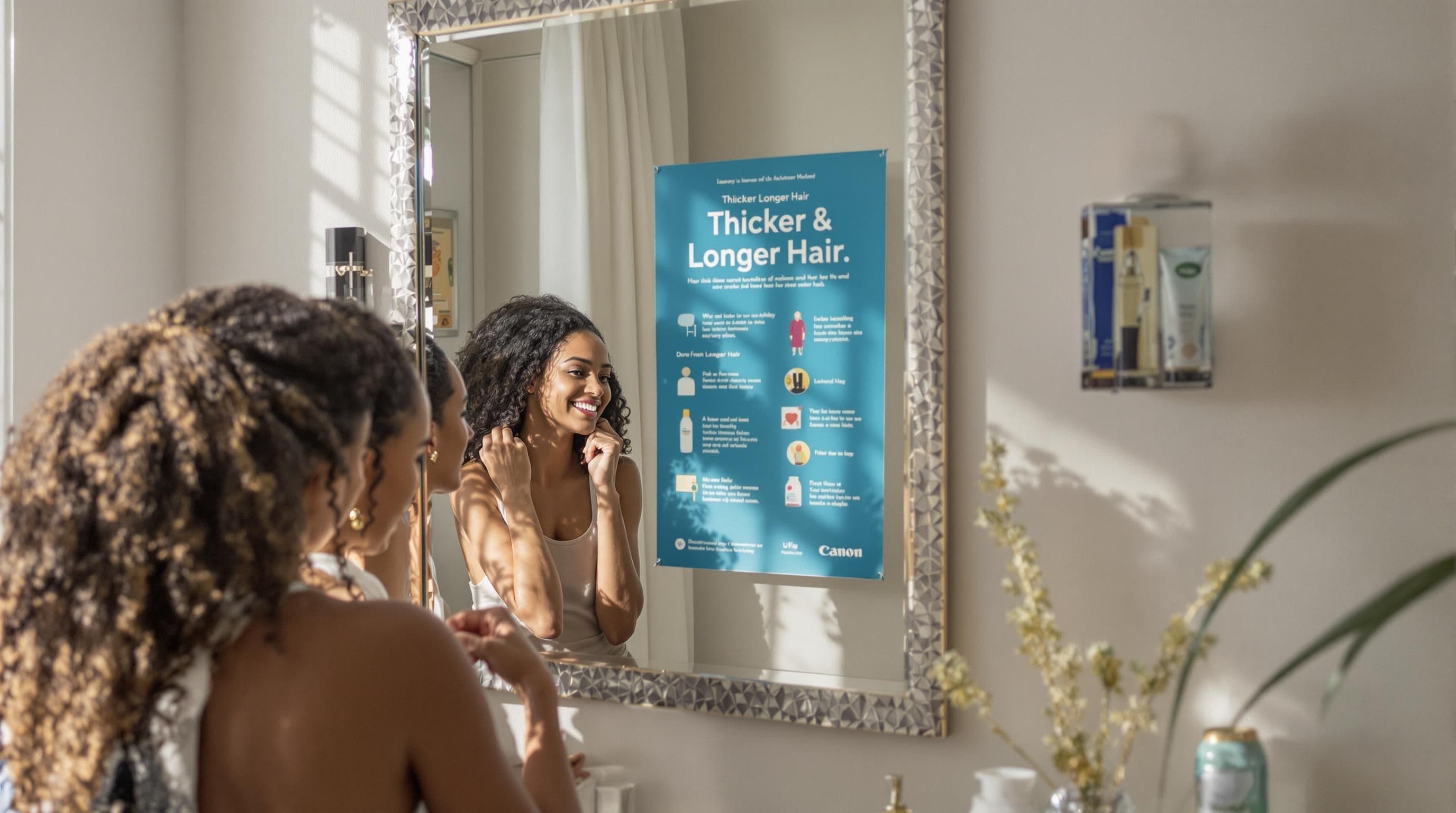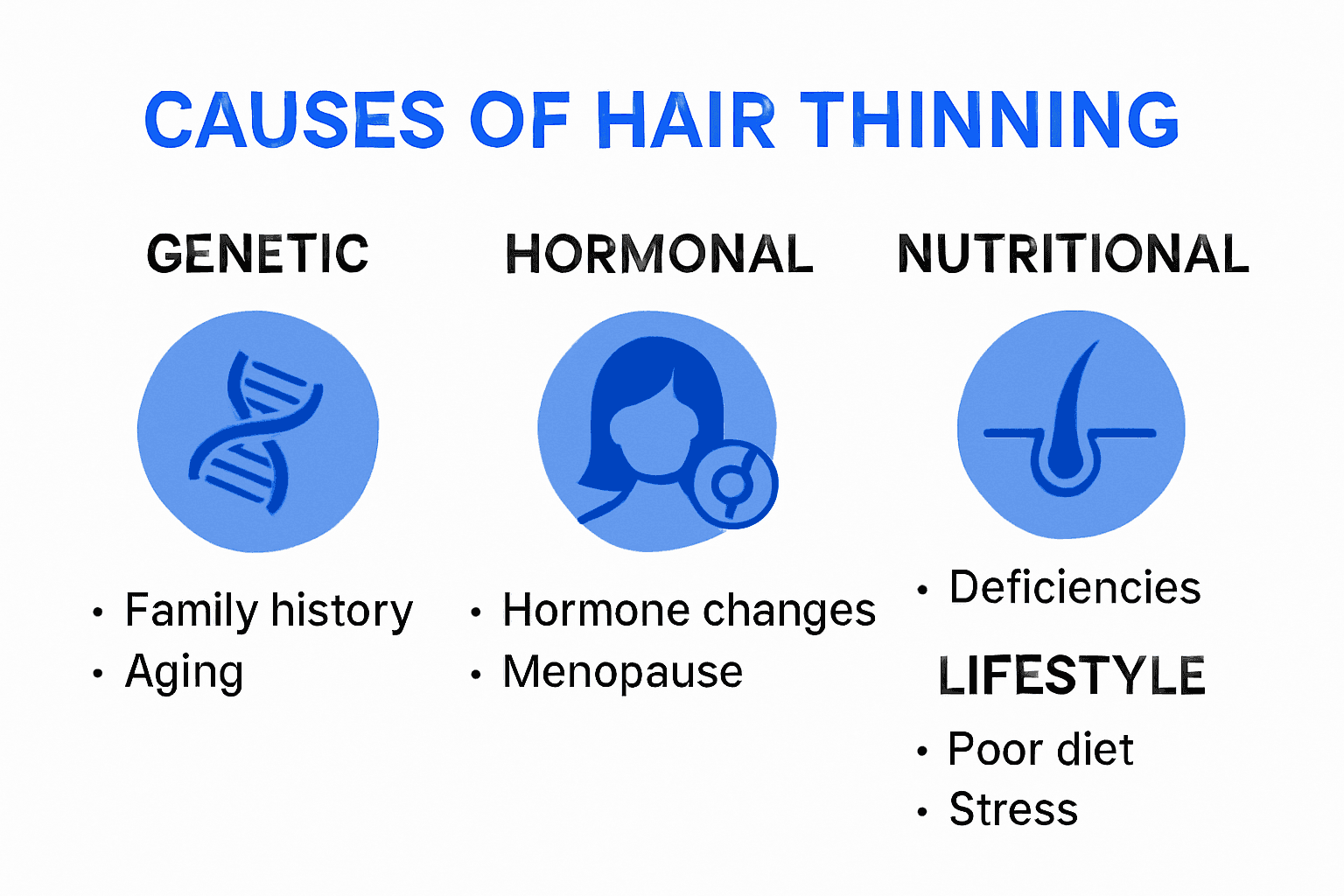Blog
Learning Materials
How to Achieve Thicker Longer Hair: Top Solutions for 2025
Updated: July 24, 2025

Millions of people struggle with hair that looks thin or refuses to grow past a certain length. Here is the part that makes you stop and take notice. About 50 million men and 30 million women in the US experience pattern baldness, yet most advice online still focuses only on shampoos or magic oils. The real breakthroughs for thicker, longer hair in 2025 go way beyond old-school remedies and combine everything from nutrient science to high-tech tracking that reveals what actually works for your unique hair.
Table of Contents
- Understanding Causes Of Hair Thinning
- Effective Strategies For Thicker Longer Hair Growth
- Personalized Hair Care Routines And Tracking Progress
- Best Products And Brands For Thicker Longer Hair
Quick Summary
| Takeaway | Explanation |
|---|---|
| Understand genetic influences on hair thinning | Genetic predisposition significantly impacts hair loss, especially through conditions like androgenetic alopecia. |
| Prioritize nutritional intake for hair growth | Diet rich in proteins, vitamins, and minerals strengthens hair follicles and promotes growth. |
| Implement gentle hair care practices | Avoid tight hairstyles and use soft hair ties to reduce stress on hair follicles and prevent hair loss. |
| Track progress with advanced techniques | Use methods like TrichoScan to monitor hair density and follicle health effectively over time. |
| Choose scientifically supported hair products | Explore proven supplements and topical treatments, like minoxidil, while consulting healthcare providers for safety. |
Understanding Causes of Hair Thinning
Hair thinning represents a complex biological process impacting millions worldwide. Understanding the underlying mechanisms helps individuals develop targeted strategies for maintaining healthy hair growth and preventing progressive loss.
Genetic and Hormonal Influences
According to the American Academy of Dermatology, hereditary factors can trigger pattern baldness, which affects approximately 50 million men and 30 million women in the United States. Androgenetic alopecia, commonly known as male or female pattern baldness, results from sensitivity to dihydrotestosterone (DHT), a hormone that shrinks hair follicles over time.
Hormonal changes also dramatically impact hair thickness and growth. Conditions like thyroid disorders, polycystic ovary syndrome (PCOS), and menopause can disrupt normal hair growth cycles. Research from Johns Hopkins Medicine reveals that hormonal imbalances can cause sudden hair shedding or gradual thinning, making it crucial to understand these underlying biological mechanisms.
Here's a table summarizing the major causes of hair thinning as described in this section:
| Cause Category | Specific Factor | Description |
|---|---|---|
| Genetic | Hereditary/Androgenetic Alopecia | Pattern baldness due to sensitivity to DHT; affects ~50 million men, 30 million women in US |
| Hormonal | Thyroid Disorders | Can disrupt hair growth cycles |
| Hormonal | PCOS | Can disrupt hair growth cycles |
| Hormonal | Menopause | Disrupts normal hair cycling |
| Hormonal | Other Hormonal Imbalances | Can cause sudden shedding or gradual thinning |
External and Health-Related Factors
Beyond genetic and hormonal influences, multiple external factors contribute to hair thinning. Chronic stress, nutritional deficiencies, and certain medical treatments can accelerate hair loss. Medications for conditions like cancer, arthritis, depression, and heart problems often list hair thinning as a potential side effect. Additionally, physical and emotional stress can trigger telogen effluvium, a temporary condition causing widespread hair shedding.
Nutritional deficiencies significantly impact hair health. Insufficient intake of protein, iron, zinc, and vitamins B12 and D can lead to weakened hair structure and increased breakage. This underscores the importance of a balanced diet and potential supplementation to support robust hair growth.
Comprehending these multifaceted causes empowers individuals to take proactive steps in managing and potentially reversing hair thinning. By identifying personal risk factors and implementing targeted interventions, people can optimize their hair health and maintain thicker, longer hair.

Effective Strategies for Thicker Longer Hair Growth
Achieving thicker longer hair requires a holistic approach that combines nutrition, hair care techniques, and targeted treatments. By understanding and implementing strategic methods, individuals can significantly improve hair growth and overall hair health.
Nutritional Foundations for Hair Growth
According to Harvard Health, diet plays a crucial role in hair growth and strength. B vitamins specifically are essential for maintaining healthy hair follicles. Foods rich in biotin, such as eggs, almonds, and fortified cereals, can provide critical nutrients that support hair growth. Protein intake is equally important, as hair is primarily composed of keratin, a protein that requires consistent nutritional support.
Essential minerals like iron, zinc, and vitamin D contribute to hair follicle health. Deficiencies in these nutrients can lead to weakened hair structure and increased shedding. Incorporating lean proteins, leafy greens, nuts, and seeds can help create a nutritional environment that promotes robust hair growth.
Advanced Hair Care Techniques
The American Academy of Dermatology recommends specific hair care strategies to promote thicker longer hair. Washing hair once a week or every other week prevents product buildup that can impede hair growth. Consistent conditioning helps maintain moisture and prevents breakage, which is critical for maintaining hair length and thickness.
Hot oil treatments applied twice monthly can add moisture and improve hair elasticity. These treatments penetrate the hair shaft, providing deep nourishment and reducing the likelihood of split ends. Additionally, minimizing heat styling and using protective techniques can prevent unnecessary damage and support natural hair growth.
Preventing Hair Damage and Promoting Growth
Research published in JAMA Dermatology highlights the importance of gentle hair handling. Tight hairstyles can cause tension on hair follicles, leading to potential hair loss. Opting for looser styles and using soft hair ties can help prevent unnecessary stress on hair roots.
Regular scalp massage can stimulate blood circulation, potentially encouraging hair growth by delivering more nutrients to hair follicles. Using gentle circular motions with fingertips or a specialized scalp massager can improve scalp health and create an optimal environment for hair growth.
By combining these comprehensive strategies, individuals can develop a robust approach to achieving thicker longer hair. Consistency, patience, and a holistic view of hair health are key to seeing meaningful improvements in hair growth and overall hair quality.
Personalized Hair Care Routines and Tracking Progress

Personalized hair care represents a transformative approach to achieving thicker longer hair. By developing tailored strategies and implementing systematic tracking methods, individuals can optimize their hair growth journey with unprecedented precision.
Advanced Diagnostic Techniques
Research from recent studies has developed standardized methodologies for assessing hair health with remarkable accuracy. Modern diagnostic techniques enable comprehensive evaluations of hair density, thickness, and scalp condition. These advanced assessments go beyond traditional visual inspections, providing quantitative data that forms the foundation of personalized hair care strategies.
According to mechanical stretch stimulation research, individual hair follicle responses can be mapped and monitored. This approach reveals how unique genetic and environmental factors influence hair growth, allowing for highly customized intervention plans. By understanding individual hair growth patterns, people can develop targeted treatments that address specific challenges.
Tracking and Monitoring Technologies
The TrichoScan method represents a breakthrough in hair progress monitoring. Non-invasive digital image analysis techniques now enable precise tracking of hair regrowth and treatment responses. These technologies capture microscopic changes, providing visual evidence of hair transformation over time.
Key tracking parameters include:
- Hair density measurements
- Follicle diameter analysis
- Scalp health indicators
- Growth rate calculations
Consistent documentation becomes crucial in understanding individual hair growth trajectories. Photographing hair from multiple angles, maintaining detailed growth journals, and regularly measuring hair length can provide invaluable insights into the effectiveness of personal care routines.
Personalization Strategies
Successful hair care routines require a holistic approach that considers multiple factors. Genetic predispositions, lifestyle habits, nutritional intake, and environmental conditions all play significant roles in hair health. Creating a personalized routine involves comprehensive assessment and continuous adaptation.
Recommended personalization steps include:
- Conducting thorough scalp and hair analysis
- Identifying individual hair type characteristics
- Developing targeted nutritional and topical treatment plans
- Implementing regular monitoring and adjustment protocols
By embracing data-driven, personalized approaches, individuals can move beyond generic hair care solutions. The future of hair growth management lies in understanding and responding to unique physiological signals, transforming hair care from a one-size-fits-all model to a precision-oriented, individualized experience.
Best Products and Brands for Thicker Longer Hair
Navigating the world of hair care products requires a strategic approach to selecting solutions that genuinely support thicker, longer hair growth. Understanding the scientific backing and specific benefits of various products can help individuals make informed choices.
Scientifically Validated Nutritional Supplements
A comprehensive review in JAMA Dermatology examined multiple nutritional supplements for hair growth. Several brands demonstrated promising results, including Viviscal, Nutrafol, and Lamdapil. These supplements typically contain a blend of vitamins, minerals, and botanical extracts designed to support hair follicle health.
Key supplements that showed potential include:
- Pumpkin seed oil
- Zinc supplements
- Omega-3 and omega-6 fatty acids
- Compound glycyrrhizin tablets
- Tocotrienol complex
It is crucial to approach supplementation with careful consideration, consulting healthcare professionals to ensure individual suitability and prevent potential interactions with existing medications.
Here's a table highlighting scientifically validated supplements and their key support mechanisms, as mentioned in this section:
| Supplement or Brand | Key Ingredient(s) / Mechanism | Notable Benefit or Purpose |
|---|---|---|
| Viviscal | AminoMar marine complex, vitamins | Encourages follicle health & growth |
| Nutrafol | Botanicals, Saw palmetto, Ashwagandha, Biotin | Reduces stress-induced shedding |
| Lamdapil | Lignans, Melatonin | Balances hormones, antioxidant |
| Pumpkin Seed Oil | Plant sterols | Supports hair growth, DHT blocker |
| Zinc Supplements | Zinc | Essential for follicle health |
| Omega-3/6 Fatty Acids | Omegas | Anti-inflammatory, scalp health |
| Compound Glycyrrhizin | Glycyrrhizin (licorice extract) | Anti-inflammatory properties |
| Tocotrienol Complex | Vitamin E isomers | Antioxidant, may increase density |
Topical Treatments and Hair Growth Medications
According to NCBI research, minoxidil stands out as a scientifically proven topical medication for hair growth. This treatment works by widening blood vessels and increasing nutrient delivery to hair follicles, potentially stimulating hair growth by prolonging the active growth phase.
When considering topical treatments, users should be aware of potential side effects, which may include:
- Skin irritation
- Allergic contact dermatitis
- Rare instances of hypertrichosis (excessive hair growth)
Nutritional and Care Strategies
Harvard Health highlights the critical role of nutrition in maintaining hair health. B vitamins play a particularly important role in supporting hair growth. Specifically, vitamins B1 (thiamin), B2 (riboflavin), and B7 (biotin) contribute to converting food into energy and supporting overall hair health.
Beyond supplements, effective hair care involves:
- Gentle hair washing techniques
- Minimizing heat and chemical treatments
- Using protective hair products
- Maintaining a balanced diet rich in essential nutrients
Choosing the right products requires a personalized approach. What works for one individual may not be equally effective for another. Factors such as hair type, scalp condition, genetic predisposition, and overall health significantly influence the effectiveness of hair growth solutions.
Individuals seeking to improve hair thickness and length should adopt a holistic strategy. This involves combining scientifically supported products, proper nutrition, gentle hair care practices, and potentially consulting with healthcare or hair care professionals to develop a tailored approach to achieving thicker, longer hair.
Frequently Asked Questions
What are the main causes of hair thinning?
Hair thinning is primarily caused by genetic factors, hormonal changes, external stressors, and nutritional deficiencies. Conditions like androgenetic alopecia, thyroid disorders, and stress can significantly contribute to hair loss.
How can I promote thicker and longer hair?
To promote thicker and longer hair, focus on a balanced diet rich in proteins, vitamins, and minerals. Additionally, implement gentle hair care practices, such as minimizing heat styling and avoiding tight hairstyles. Regular scalp massages can also enhance blood circulation to the hair follicles.
Are there any effective supplements for hair growth?
Yes, scientifically validated supplements like Viviscal, Nutrafol, and Lamdapil have shown promise in supporting hair growth. Key ingredients often include vitamins, minerals, and botanical extracts that help maintain healthy hair follicles.
What are the best topical treatments for hair growth?
Minoxidil is a well-researched topical treatment for hair growth. It works by increasing blood flow to hair follicles and prolonging the growth phase of hair. However, potential side effects like skin irritation should be considered before use.
Ready for Thicker, Longer Hair? Discover Your Personalized Path Now
If you are frustrated by hair that feels thin, never seems to grow, or changes texture without warning, you are not alone. The article above explained how genetic factors, nutrition, and daily hair care routines all play a crucial role in the journey to thicker hair. But guessing what works for you and following generic advice can leave you feeling overwhelmed and discouraged.

Why settle for generic solutions when your hair is unique? Take the guesswork out of hair growth by starting a tailored analysis on MyHair.ai. Upload your scan to receive AI-powered recommendations that track your progress, show real changes over time, and point you toward products backed by science. Stop chasing hit-or-miss remedies and get real answers made for you. Visit MyHair.ai now and start seeing meaningful improvement today.